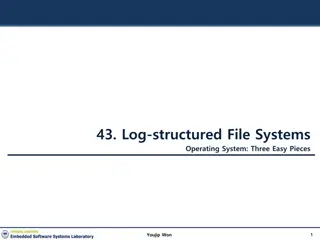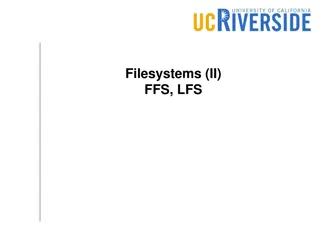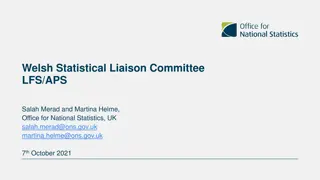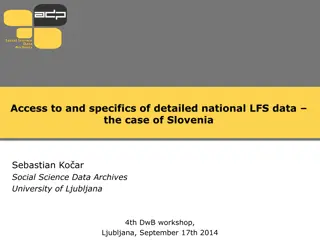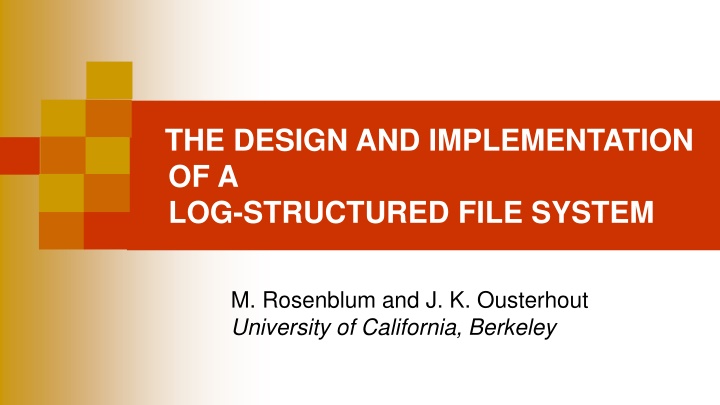
Log-Structured File System: Design and Implementation Overview
Explore the innovative log-structured file system architecture designed by M. Rosenblum and J. K. Ousterhout at the University of California, Berkeley. This system emphasizes sequential writes, optimizing disk access times, and improving data storage efficiency. Discover key ideas, workload considerations, limitations of traditional file systems, and the crucial concept of writing modifications to disk in a log-like structure.
Download Presentation

Please find below an Image/Link to download the presentation.
The content on the website is provided AS IS for your information and personal use only. It may not be sold, licensed, or shared on other websites without obtaining consent from the author. If you encounter any issues during the download, it is possible that the publisher has removed the file from their server.
You are allowed to download the files provided on this website for personal or commercial use, subject to the condition that they are used lawfully. All files are the property of their respective owners.
The content on the website is provided AS IS for your information and personal use only. It may not be sold, licensed, or shared on other websites without obtaining consent from the author.
E N D
Presentation Transcript
THE DESIGN AND IMPLEMENTATION OF A LOG-STRUCTURED FILE SYSTEM M. Rosenblum and J. K. Ousterhout University of California, Berkeley
THE PAPER Presents a new file system architecture allowing mostly sequential writes Assumes most data will be in RAM cache Settles for more complex, slower disk reads Discusses a mechanism for reclaiming disk space Essential part of paper
OVERVIEW Introduction Key ideas Data structures Simulation results Sprite implementation Conclusion
INTRODUCTION Processor speeds increase at an exponential rate Main memory sizes increase at an exponential rate Disk capacities are improving rapidly Disk access times have evolved much more slowly
Consequences Larger memory sizes mean larger caches Caches will capture most read accesses Disk traffic will be dominated by writes Caches can act as write buffers replacing many small writes by fewer bigger writes Want to increase disk write performance by eliminating seeks
Workload considerations Disk system performance is strongly affected by workload Office and engineering workloads are dominated by accesses to small files Many random disk accesses File creation and deletion times dominated by directory and i-node updates Hardest on file system
Limitations of existing file systems They spread information around the disk I-nodes stored apart from data blocks Less than 5% of disk bandwidth is used to access new data Use synchronous writes to update directories and i-nodes Required for consistency Much less efficient than asynchronous writes
KEY IDEA Write all modifications to disk sequentially in a log-like structure Convert many small random writes into fewer large sequential transfers Use I/O cache as write buffer
Main advantages Replaces many small random writes by fewer sequential writes Faster recovery after a crash All blocks that were recently written are at the tail end of log No need to check whole file system for inconsistencies Like UNIX and Windows 95/98 did
THE LOG Only structure on disk Contains i-nodes and data blocks Includes indexing information so that files can be read back from the log relatively efficiently Most reads will access data that are already in the cache Will it always remain true?
Disk layouts of LFS and UNIX dir1 dir2 Disk Log LFS file2 file1 file1 file2 Disk Unix FFS dir1 dir2 Inode Directory Data Inode map
Index structures I-node map maintains the location of all i-node blocks I-node map blocks are stored on the log Along with data blocks and i-node blocks Active blocks are cached in main memory A fixed checkpointregion on each disk contains the addresses of all i-node map blocks at checkpoint time
Accessing an i-node Fixed location but not up to date Checkpoint Area I-node map blocks spread over the log Log I-node blocks also spread over the log Log
The way it works Fixed location but not up to date Checkpoint Area Active blocks cached in RAM I-node map blocks spread on the log Log I-node blocks also spread on the log Active blocks cached in RAM Log
Segments Must maintain large free extents for writing new data Disk is divided into large fixed-size extents called segments 512 kB in Sprite LFS Segments are always written sequentially From one end to the other Old segments must be cleanedbefore they are reused
Segment usage table One entry per segment Contains Number of free blocks in segment Time of last write Used by the segment cleaner to decide which segments to clean first
Segment cleaning (I) Old segments contain live data dead data belonging to files that were overwritten or deleted Segment cleaning involves writing out the live data A segment summary block identifies each piece of information in the segment
Segment cleaning (II) Segment cleaning process involves 1. Reading a number of segments into memory 2. Identifying the live data 3. Writing them back to a smaller number of clean segments Key issue is where to write these live data Want to avoid repeated moves of stable files
Write cost u = utilization
Segment Cleaning Policies Greedy policy: always cleans the least-utilized segments
Simulation results (I) Consider two file access patterns Uniform Hot-and-cold: (100 ?)% of the accesses involve x% of the files 90% of the accesses involve 10% of the files A rather crude model
Greedy policy No variance = formula
Key No variance displays write cost computed from formula assuming that all segments have the same utilization u (not true!) LFS uniform uses a greedy policy LFS hot-and-cold uses a greedy policy that sorts live blocks by age FFS improved is an estimation of the best possible FFS performance
Comments Write cost is very sensitive to disk utilization Higher disk utilizations result in more frequent segment cleanings Free space in cold segments is more valuable than free space in hot segments Value of a segment free space depends on the stability of live blocks in segment
Copying live blocks Age sort: Sorts the blocks by the time they were last modified Groups blocks of similar age together into new segments Age of a block is good predictor of its survival
Comments Locality causes the distribution to be more skewed towards the utilization at which cleaning occurs. Segments are cleaned at higher utilizations than they could
Cost benefit policy Uses criterion
Using a cost-benefit policy 75% 15%
What happens Hot and cold segments are now cleaned at different utilization thresholds 75% utilization for cold segments 15% utilization for hot segments And it works much better!
Comments Cost benefit policy works much better
Performance overview Sprite LFS Outperforms current Unix file systems by an order of magnitude for writes to small files Matches or exceeds Unix performance for reads and large writes Even when segment cleaning overhead is included Can use 70% of the disk bandwidth for writing Unix file systems typically can use only 5-10%
Crash recovery (I) Uses checkpoints Position in the log at which all file system structures are consistent and complete Sprite LFS performs checkpoints at periodic intervals or when the file system is unmounted or shut down Checkpoint region is then written on a special fixed position; contains addresses of all blocks in inode map and segment usage table
Crash recovery (II) Last checkpoint The log Roll forward Checkpoint Area
Crash recovery (III) Recovering to latest checkpoint would result in loss of too many recently written data blocks Sprite LFS also includes roll-forward When system restarts after a crash, it scans through the log segments that were written after the last checkpoint When summary block indicates presence of a new i-node, Sprite LFS updates the i-node map
SUMMARY Log-structured file system Writes much larger amounts of new data to disk per disk I/O Uses most of the disk s bandwidth Free space management done through dividing disk into fixed-size segments Lowest segment cleaning overhead achieved with cost-benefit policy
ACKNOWLEDGMENTS Most figures were lifted from a PowerPoint presentation of same paper by Yongsuk Lee
For further discussion Remzi Arpaci-Dusseau and Andrea Arpaci-Dusseau, Operating Systems: Three Easy Pieces, Arpaci-Dusseau Books. Chapter on log-structured file systems http://pages.cs.wisc.edu/~remzi/OSTEP/file-lfs.pdf


